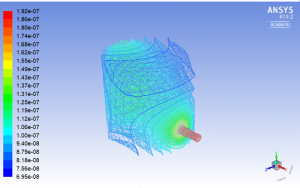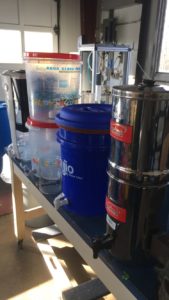Research Interview with Akshay Delity
Author: Stephen Stamegna
Background:Akshay Delity is a senior mechanical engineering student and an undergraduate member of the Kumpel Research Group at the University of Massachusetts, Amherst. He is currently pursuing his Honors Thesis in the field of drinking water quality.
Q: Could you tell me a little bit about your thesis?

A: The title is An experimentally backed computational model of intermittent water storage tanks. So basically, I’m using CFD (Computational fluid dynamics) to calculate different characteristics of a storage tank (temperature, hydraulic residence time, etc.) and examine the effect of different inlet and outlet geometries on microbial growth.
Q: What do you hope to achieve through this research?
A: Ideally, I’m hoping to create a plug-and-play model. The inputs would be storage tank characteristics such as temperature, hydraulic residence time, and most significantly, inlet and outlet geometries. The output would simply be a value for microbial growth. The purpose of the model is to inform the process of optimizing the tank to increase mixing, decrease stagnation, and in turn, decrease microbial growth. The end product of my thesis will be a recommendation for optimal inlet and outlet geometries.
Q: As of now, what are your methods for conducting the lab tests?
A: Right now, I’m still working on the computer model and running simulations. Each simulation takes between 2-4 days. The reason it takes so long is because I’m tracking a lot of parameters; I split the tank up into 25,000 differential elements and I’m monitoring the changes in the parameter values in each of those elements.
Q: Have you experienced any complications in your research?
A: I didn’t have knowledge in CFD before I proposed the project. So I’ve been learning it on the job. One big complication was switching from steady state modelling where all the boundary conditions (inlet flow, air-water mixture inside the tank, radiation, conduction, etc.) remain the same to transient modelling where the boundary conditions are constantly changing. Because of that, I was getting results that I thought were right, but they weren’t actually accurate.
Q: Have you figured out how to solve that complication?
A: For the most part, yes. With every iteration, you have to specify more things so it takes longer each time. So it’s a slow process, but I’ve figured out how to manage it.

Q: How does your research relate to the research group at large?
A: Water storage is an integral component of any intermittent water system and we focus on intermittent water supply in the research group. Water quality is often generally poor in intermittent systems so hopefully this model can provide a simple way to improve a system component very easily; all you have to do is change geometries of the inlets and outlets once you use the model.
Q: Why did you get involved in research as an undergraduate student?
A: Engineers Without Borders (EWB) was my main influence. As soon as Dr. Kumpel joined the faculty, her research focus seemed to be the perfect segue to what I was already doing with EWB and I wanted to get involved in the research group.
Q: Why did you choose your project in particular?
A: Through my work with EWB and in the research group, it became clear that I couldn’t come up with a single novel technology that could improve all the problems associated with IWS. However, I still wanted to use my mechanical engineering background to improve some technical portion of an IWS system. I learned that behavioral changes are often the main improvements that can be made to influence water quality. So I chose a project that would incorporate my technical knowledge while addressing a behavioral change that could be made that would have a big effect on water quality.





 A: We figured that it would be possible to measure the log removal if the initial concentrations were even higher than those of the Mill River water. So our first attempt to solve the issue was to use secondary effluent from the Amherst Wastewater Treatment Plant. However, the same issue has risen with this water as well. These observations have raised some noteworthy points. It is interesting that the initial concentrations between the Mill River water and the secondary effluent are so similar. Additionally, if the final concentrations are so low, these devices are most likely very effective at removing contaminants. This is a good thing, but it makes it difficult to label metrics to the effectiveness each device.
A: We figured that it would be possible to measure the log removal if the initial concentrations were even higher than those of the Mill River water. So our first attempt to solve the issue was to use secondary effluent from the Amherst Wastewater Treatment Plant. However, the same issue has risen with this water as well. These observations have raised some noteworthy points. It is interesting that the initial concentrations between the Mill River water and the secondary effluent are so similar. Additionally, if the final concentrations are so low, these devices are most likely very effective at removing contaminants. This is a good thing, but it makes it difficult to label metrics to the effectiveness each device.